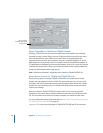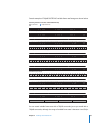
Chapter 2 Working with DVCPRO HD 51
Outputting Sequence Timecode Using DVCPRO HD
When you output a DVCPRO HD sequence or clip to a DVCPRO HD device via FireWire,
timecode is also output. This works during Print to Video and Edit to Tape operations,
as well as during normal playback when external video output via FireWire is enabled.
For more information, see the Final Cut Pro 6 User Manual, Volume IV, Chapter 14,
“Assemble and Insert Editing Using Edit to Tape.”
∏ Tip: You can also set a custom starting timecode number when you use the black and
code feature with DVCPRO HD tapes. For more information about using the black and
code feature in Final Cut Pro, see the Final Cut Pro 6 User Manual, Volume IV, Chapter 13,
“Preparing to Output to Tape.”
Note: Drop frame timecode is supported when you prepare a 720p tape with black
and timecode.
Using the DVCPRO HD Frame Rate Converter
Some 720p DVCPRO HD camcorders can record at variable frame rates, a feature once
exclusive to film cameras.
In film, the traditional frame rate is 24 fps, but many cameras can be “overcranked” or
“undercranked” to achieve slow- and fast-motion effects. The technique is straightforward:
the more frames you record per second, the longer it takes to play them back at 24 fps,
and therefore the slower the motion onscreen. The reverse is also true: the fewer frames
you record per second, the faster the motion when played back at 24 fps.
Choosing an Intended Playback Rate
Variable frame rate recording with DVCPRO HD works the same way it does with film,
except that the final playback rate varies (24, 25, 30, 50, or 60 fps) depending on your
final output format. During shooting, you need to have an intended playback rate in
mind to know what frame rate to record your footage at. For slow-motion effects, you
need to record at a frame rate higher than your intended playback rate. For fast motion,
shoot at a frame rate lower than your intended playback rate.
For example, if you shoot at 60 fps and play back your footage at 24 fps, the result will
be slow motion because the rate at which you recorded was higher than the final
playback rate. However, if you record at 24 fps and play back your footage at 24 fps,
your footage will play at normal speed.


















